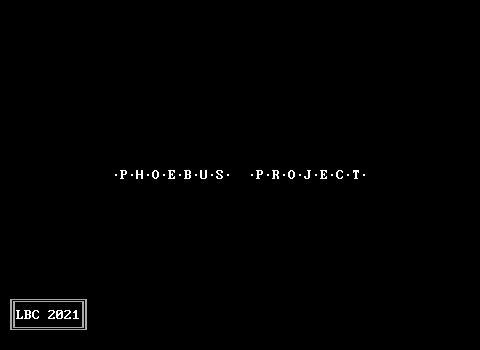With the release of ZZT, Tim Sweeney had a clever idea to both promote the game and get some new games out of it that could be distributed in the future. In the original "About ZZT" screen which pops up on the program's launch, there was a link for a world creation contest.
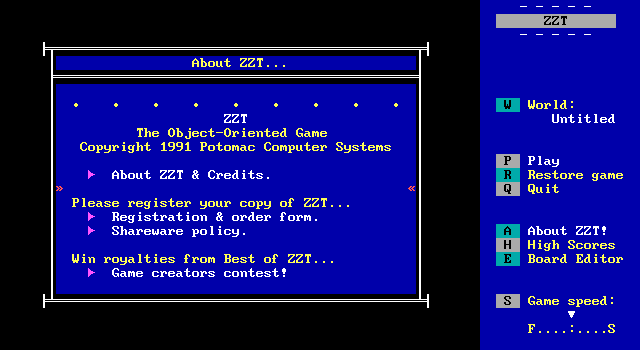
Players who found themselves captivated with Town and curious about ZZT's editor would find a the contest to be a powerful motivator. All they had to do was create an action board, a puzzle board, or a short game by December 1st, 1991, mail it to the Sweeney residence, and wait patiently and hopefully for a letter in the mail indicating that their creation was to be included in the upcoming "Best of ZZT" compilation to arrive.
The contest for Tim was hugely successful. It introduced him to Allen Pilgrim, who would be recruited into a job at the still in its infancy Epic MegaGames. It almost got him to snag Beth Daggert, whose contest entry Ezanya would become an early classic. Her entry won for good reason, though the planned hiring and commissioning of an Ultima-style fantasy role playing action game wound up falling through due to Daggert needing money in advance if she was to change to a career in games programming.
The number of submissions was more than anticipated, with the quality being high enough that the contest was expanded, giving us two Best of ZZT games that compiled submitted boards into two full length adventures, along with ZZT's Revenge which showcased the submitted games.
The contest's victors lived on as victors always do. A considerable number of 1991 ZZT worlds that survive today are those included in ZZT's Revenge. Not everyone could be a winner though, with an unknown number of submissions never getting released independently after the contest was over.
The Epic MegaGames newsletter for Spring 1992 includes a list of honorable mentions, dropping the names of forty-eight precambrian ZZTers whose submissions were "very, very good", but not good enough to be be declared a winner. The list of names is full of people that none of us know anything about. Just a whole bunch of people that made a board, or maybe even a game, saw it didn't get accepted, and just moved on and did other things.
If you look closely at the names, you'll discover that not everyone is a stranger. Some, namely James Holub (The Lost Pyramid) along with Jerry Hsu and Jesse Chang (Starbase ZZT), had so much fun with ZZT that they kept creating. Perhaps some of their early releases were originally submitted to the contest. Some dates suggest a possibility, but none explicitly mention being created for it. The dates of their files are all after the contest deadline, making it pure speculation as to whether the games were tweaked before general publication or if they weren't the games put on a disk, posted in the mail, and never seen again.
The ambiguity isn't quite so strong with Inn of the Cow. That list of honorable mentions includes the duo of Jay Shapiro and Nancy Babyak. The game is dated November 1991. The timing is perfect to get in just before the contest deadline.
Admittedly it's not conclusive evidence, but it was on the back of my mind the entire time I played. Is this an early ZZT reject? How would it compare to the likes of Ezanya and Smiley Guy? How honorable is the mention Sweeney gave the team by printing their names in a newsletter? Is it a step above other 1991 worlds whose authors names aren't listed in the newsletter?
None of this was mentioned on the poll where patrons voted on investigating the game. For them, it was simply a game with "cow humor" and "cow art". Whether the patron who nominated it had any idea themselves is also unknown! Perhaps it was just a game with an interesting name from ZZT's earliest days. The names Jay Shapiro and Nancy Babyak were likely to mean nothing to anyone that hasn't noticed that one tiny blip in a thirty-three year old newsletter.
Regardless of the whys, I was looking forward to what 1991 had to offer, especially if it occupied the weird space of being submitted, but not accepted for the Best of ZZT contest.



It starts out pretty innocently. Your Town inspired welcome message, multiple exits, and some buildings along the street to venture into, with one mapping well to Town's armory. The street is more reminiscent of City, but that's common enough for 1991 when the original games were likely the only ZZT worlds most players had available.
Still, it feels a bit off. The opening provides no goal for players other than to go exploring. The buildings are filled with forest tiles. It immediately comes off as a bit rough. Town provides a more impressive opening. Given how many games throughout the years, especially first releases, amounted to second-rate rehashes of Town, there's really nothing that out of the ordinary.
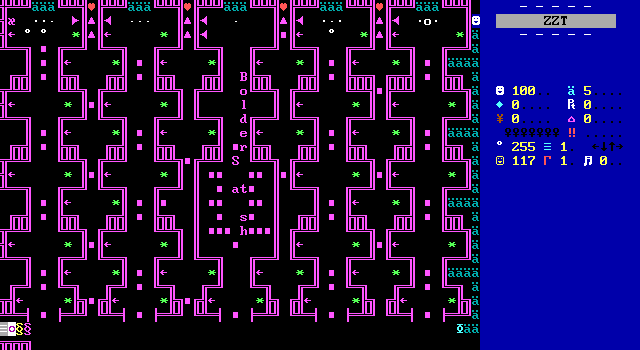
Enter the weapon store and the game immediately stops being Town. Players of Inn of the Cow will quickly learn that the game doesn't worry too much about making sense. This isn't a shop. This is a bizarre "Bolder Stash".
First off: excellent pun! A board of that name would fit right in to a purple key adventure. What you get though, is hardly a screen that would end in a purple key. Ammo is handed out in vast quantities, with a theoretical infinite more thanks to a dozen duplicators lining the top of the board.
The goal is unclear at first. A few objects and a locked door block the exit. A sits in the corner, which is probably relevant. There are hearts behind pushers that can't be reached. It's weird, and it's so purple that it's hard to read the board.
Touching the first barrier to the exit informs players they need to collect all the gems to exit. What gems? Well, the ones that the same object changes all the pushers into. Prior to this, a number of the columns are pointless to ascend, and afterwards, if you've climbed to a duplicator for the extra ammo, you're now going to have to climb again to get the gems.
It's a slow and repetitive action board that at least ensures players won't need to worry about getting ammo anytime soon.
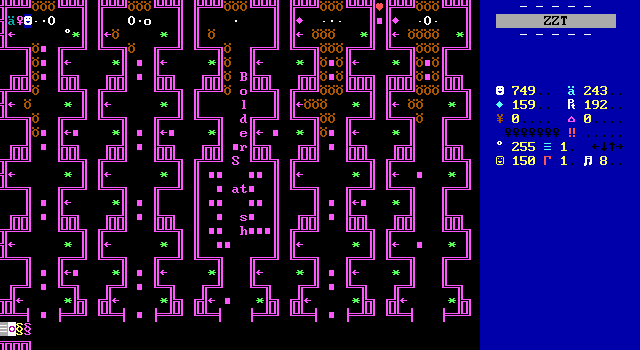
...Until they touch the ligature that simultaneously places the key needed to leave and replaces any ammo on the screen with bears. Sure, why not?
Players may already have had this bear-transformation happen as a number of the board's boulders are objects that do the same thing sans-key. Inn of the Cow is not afraid to troll players, years before anybody would describe such things as trolling. This board is just the beginning.
Baffling code designs are everywhere. The hearts give health and take ammo. The ligature wants to change ammo into lions if it's shot and into bears again if it's bombed. There are no bombs on this board. Be thankful, as shooting/bombing would turn the object into ammo without it dropping the key needed to exit. Not that such a soft-lock matters as the code incorrectly uses the labels :shoot and :bomb instead of :shot/:bombed. Even if the correct labels were used, the object also incorrectly attempts to execute #become seek ammo for those two broken labels. Only using the correct syntax for touching.
Similarly, the reward for completing the board is bugged, denying players a whopping 4000 ammo due to another syntax error.
At least the board's purpose is clear enough. It might not be a weapon shop on the inside, but it provides enough ammo to get the game underway.

The second building doesn't have a passage to enter, letting players just speak to the man inside without a transition. The travel agency better establishes what the game's deal is. You have arrived here in Bossyville in search of adventure. The travel agency offers a few vacation packages for the region.
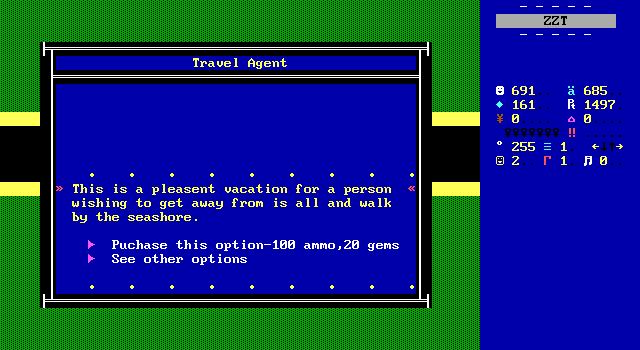
These vacation destinations are accompanied by pleasant descriptions before presenting players with the price tag. Inn of the Cow being what it is, that price isn't exclusively in gems.
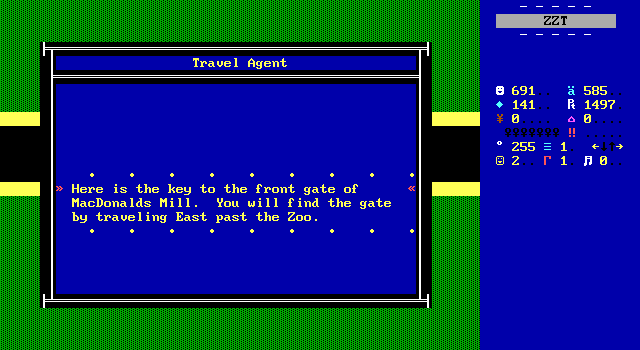
As a justification for adventure, I quite like it. Relaxing and thrill-seeking vacations are a fun way to give players reason to explore a setting for reasons other than finding purple keys or similar macguffins. The format is flexible enough that any number of vacation packages could add up to a full length game, and everything is vague enough still that your ultimate goal can be revealed later instead of doing so immediately up front.
Not wanting to spend all my money at once, I didn't initially explore the other options. The third of which has the agent explain that people who have taken this package have gone missing. Not backing down gets them to acquiesce to your bravery, giving you the keys from the other two packages without spending any money in the process.
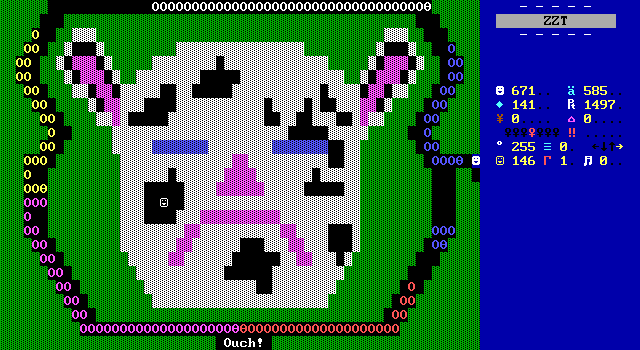
West of the start is this excellent drawing of a cow face that was enough to convince me when I saw the game had won the poll that there would be something worth showing in it. The poor thing looks rather sad for a game meant to be more humorous.
I made the mistake of assuming I wouldn't be dropped directly into danger and immediately ran through a thin forest wall only to be harassed by centipedes. Mind how you exit boards in this game, as a number of mishaps like this can happen if you're a little too forward about moving forward.
Many times in streams I've cited extra long centipedes as a tell-tale sign of a new ZZTer. An irresistible urge to see just how long you can make the things. Given that this games is from ZZT year one, I suppose it's not that surprising to run into them here.
The giant centipede is a misunderstood creature in my eyes. Unlike a lot of other signs of inexperienced authors, the giant centipede is rarely a problem unless the geometry of the board means players have to shoot the entire creature into nothing. Their size makes them very easy to track their movements, and as only the head will ever attack players directly, you can take advantage of the oversized body as a shield from more aggressive and spread out foes.
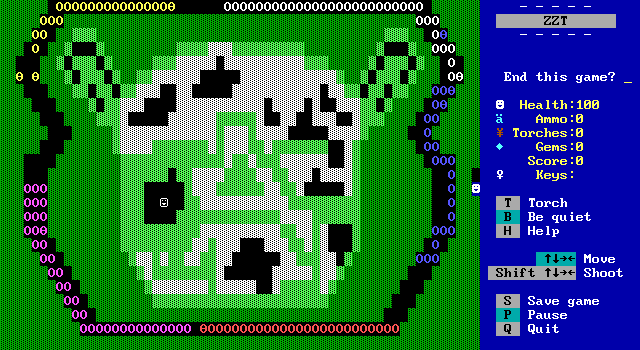
The cow face is a weird mashup of normals and fakes, again with no rhyme or reason. It's not a maze by any means, with only one tiny dead end on part of the lips. It is instead a bit of a nuisance, perhaps to tempt players to just go through the forest and set loose the centipedes.
In a typical ZZT game, a board like this would have some sort of goal. Maybe players would have to deal with the centipedes, maybe they could sneak around. The cow would have some item players would need in order to get past some obstacle, a key or item. Maybe it would just be a chance to earn some points and grab a treasure.
#end
:touch
Welcome kind stranger to our once gentle
land. Fear has struck the hearts of cows
everywhere! The golden pitchfork has
been stolen from the farmer in the dell
and ole' farmer MacDonald is about to
file bankruptcy if you do not save them!
To help you on your way the only advice
that I can give you to walk carefully
and protect your towel at all times!
• • • • • • • • •
The reward for reaching the odd smiley face is the game's actual story. The travel agent framing? It's still there, and relevant to some degree as you can get keys to specific areas buy purchasing a vacation. The player's actual goal is initially revealed here, an entirely optional board that might not be visited for a very long time if the player opted to explore the east of the starting board first.
The actual story is dealing with two bespoke crises. One missing macguffin, golden pitchfork, means an end of peace and prosperity for the farms. A very typical adventure game goal of restoring a missing artifact to its rightful place. The other, a more realistic affair of a farmer unable to keep up with loan payments is about to lose his farm.
With a Hitchhiker's Guide reference to making sure to hold on to one's towel. This is one of the few tiny morsels of information on the authors who are otherwise udder-unknowns (Not sorry). They were, at the very least, well read. It's been some time since I've last read the series, but I don't think there are any other references to be found in the game. It's not just a reference here either, players are expected to find a towel in order to reach the final section of the game.
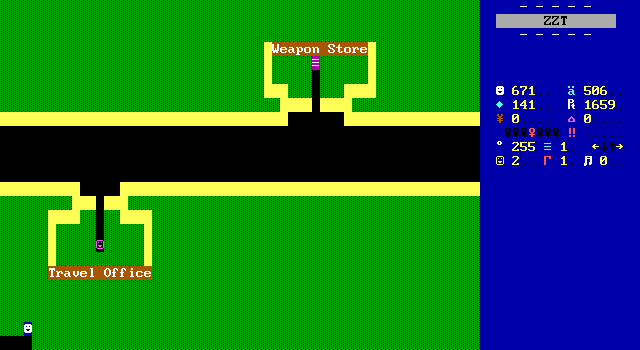
The open layout of the cow board means it's very easy for players to find themselves outside the critical path (or annoyingly blocked if they line up with a wall). Later boards will make it clear that these kind of connections are a feature, not a bug. Still, it's rather annoying as the opportunities to get back on the main path are limited while reasons to want to be on the outside are few and far between.
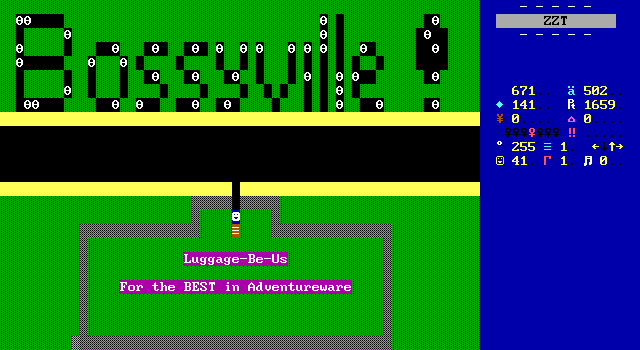
Getting back on the road presents players with more businesses to patronize, and some neatly written text in the grass along the curb.
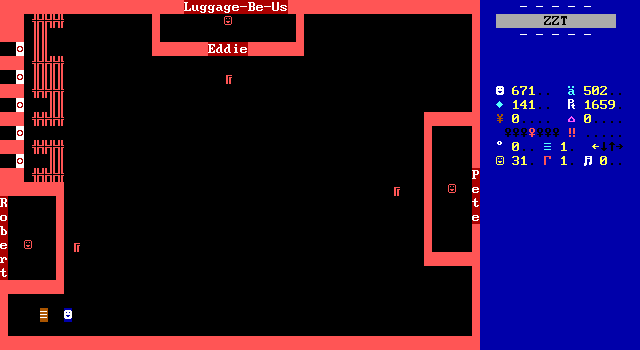
It's one thing to have a gag item, it's quite another to have a gag store. Luggage-Be-Us features an interior that one would look at and actually say "this is a place of business" compared to the weapon store, though it too is misleading if you're expecting the usual purchases you see in ZZT worlds.
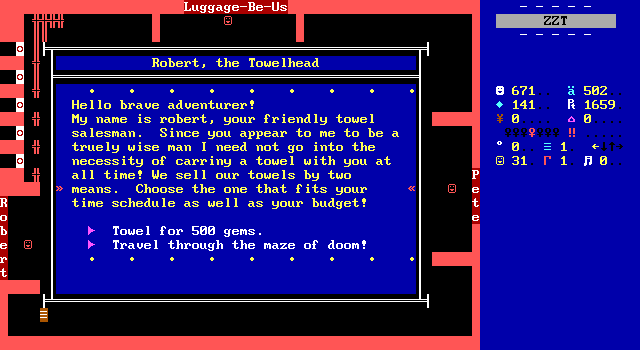
Alas, it's almost exclusively funny business. Robert sells towels, the one item in the game that is supposed to be mandatory to complete it. The exorbitant pricing (500 gems) and alternate means of purchase make it seem like players aren't actually intended to buy a towel here, though it will work.
The other shopkeepers, Pete and Eddie, exist entirely to drain your wallet. Pete sells pitchforks of varying sizes, accompanied by descriptions that suggest where they'd be useful that correspond with the vacation packages. This makes it easy to fall for the sales pitch. My assumption was that either these would be melee weapons similar to those purchased in Adventure to slay boss monsters, or a more simple package of ammo and perhaps other items that the authors would suggest having to comfortably get through the vacation destinations.
Instead, making one of these purchases takes the money and gives nothing but a little blurb in return. The little stool used to interact with the clerk vanishes afterwards as well, so seeing all the messages about enjoying your vacation or being ready for anything won't happen.
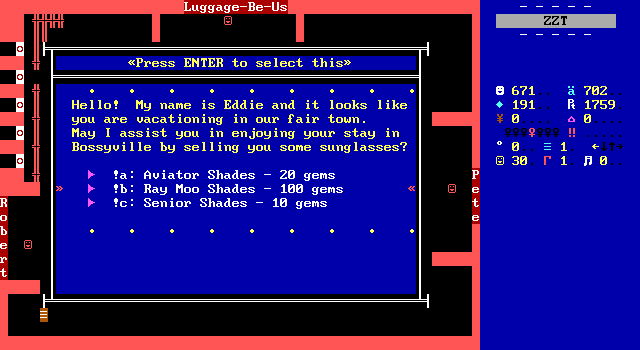
Eddie is the same. His trade is in sunglasses, where there is at least an attempt at a joke to be had with the "Ray Moo" brand.

The towel is better acquired by just entering the "Maze-O-Doom", a dark room consisting of a series of rectangles-within-rectangles made out of invisible walls where players need to find the gaps to make it to the next layer. It's not much of a maze really, which I'm thankful for.
You'll have to fight bears and centipedes as you explore the maze, which makes for easy shooting down the narrow tunnels. A pair of duplicators share a lion that in an attempt to make things spicier. This plan is foiled due to the limited space for them to roam once duplicated. One side almost immediately runs into a row of gems, and the other hits a pile of bears that will be clumped together until the player reaches them, keeping the lions in check.
One nice thing to say about the board is that the walls are turned into fakes once the end is reached. You get your towel, and are free to make a hasty exit.
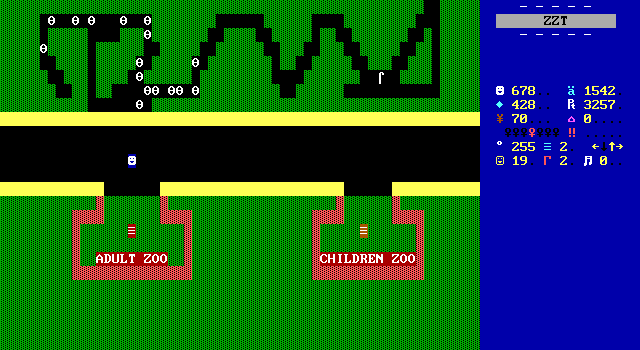
The game has an usual structure of a very elongated town. Basically everything on the road could have been placed onto a starting board rather than being spread out like this. The fact that no building has felt particularly relevant to the player's vacation plans or made any mention of the missing pitchfork leads to feelings that this is going to be a rather slow moving game. Nothing is happening here to change the status quo. I've just been amassing supplies, and with more than one thousand ammo and over six hundred health, amassing more doesn't sound very appealing.
Sadly, the next two locations, a pair of zoos for adults and children (not containing them!) do not break the trend.
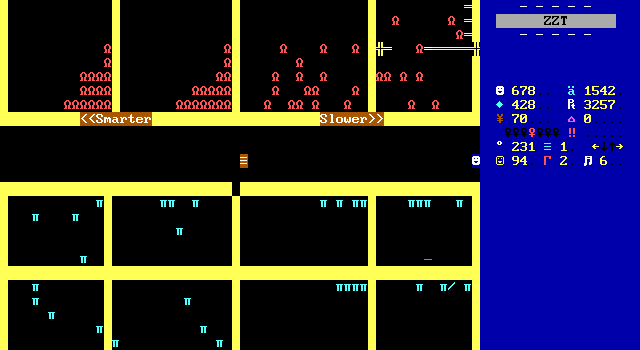
At first, it's understandable what Shapiro and Babyak were going for, a soft and in-world tutorial to demonstrate the various creatures of ZZT and how their parameters dictate their behavior. Outside of Demo, these often take the form of a zoo as a logical way to present players with dangerous animals in a safe environment. Aceland has its museum, Daedalus' Obelisk has its zoo. Inn of the Cow is just an early example of creatures being kept safely behind bars.
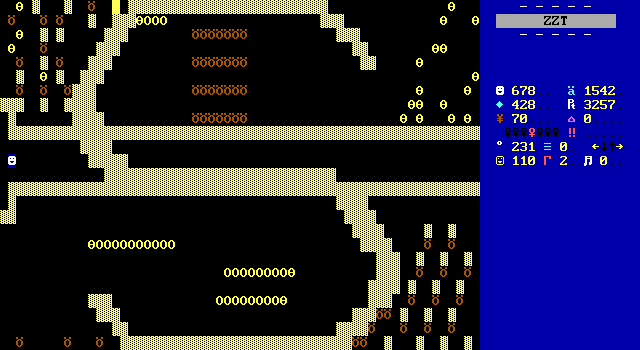
The rest of the zoo... is just weird. You get boards like this that blend normals and fakes together, with a layout that strongly encourages players to ignore the creatures that they can get at and to just press onward.
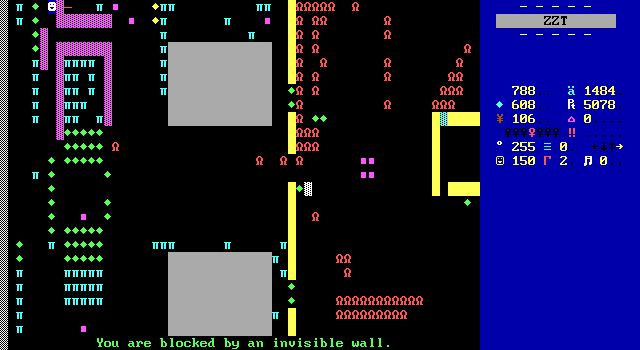
You also get this monstrosity. A board filled to the limit with creatures and built from invisible walls that make it difficult to reach them. A sign in an earlier room calls it target practice, making for a rather unethical zoo.
Players have no real reason to be here unless they do just want to shoot things for the sake of it. Torches and gems offer up some more supplies, but by this point already the player is considerably loaded. Not so much as to be completely free from consequences of poor play, but free enough that more gems is not going to hold players' interest.
The authors however, cannot get enough of this board. It's recycled repeatedly, with four boards of the game being almost identical. The far ends of the adult zoo as well as the far ends of the children's zoo are both copies of this board. At least it plays a bit differently depending on which side it's approached from.
Other differences include half being dark and half being lit. The children's zoo variations include some boulders as makeshift barriers for protection. The adult zoo has more enemies as well. In each zoo, one of the target practice boards contains a row of duplicators with gems allowing for an easy source of infinite wealth.
At the time, players won't realize this. Coming at the board from both sides, with one being dark means it'll take a little bit before you realize that the board is the same. There's also a pattern of invisible walls that forms a large "197". A reasonable assumption would be that the number will be used as a passcode in the future which would give exploring the board some purpose (albeit, not exploring it four times). The number ultimately goes unused, so I can now simply report the boards to be nothing more than a way to get more cash in game where you'd have to go through extreme lengths to run out of supplies.
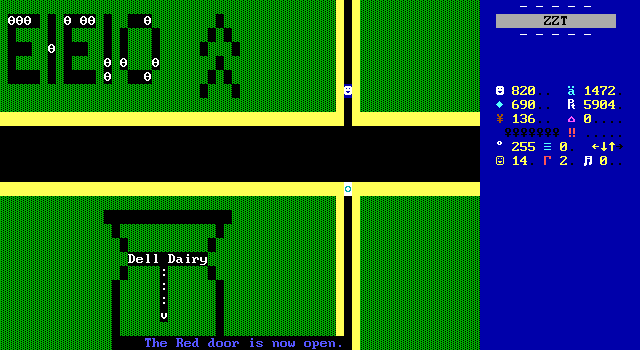
Continuing down the main street, the road comes to an end and splits off north to MacDonald's farm and south to the Dell dairy. While the road clearly continues to the east, there is no board connection there, pretty much guaranteeing players will try to continue to the east only to be stopped silently at the edge.
So far, things have been rather aimless. I was eager to get off this street and hopefully head to something that had any connection with the game's story.
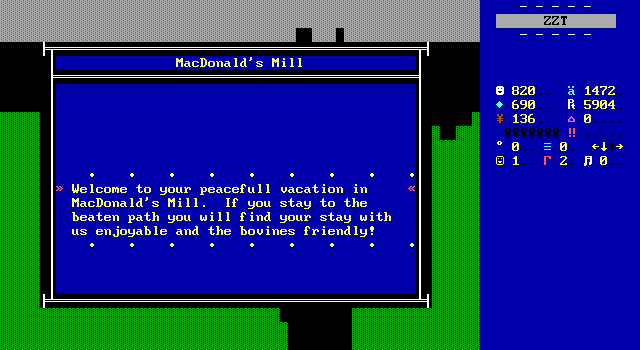

What follows however, is a lot of walking through some very empty rooms. You've got your lake water and your grassy forest.
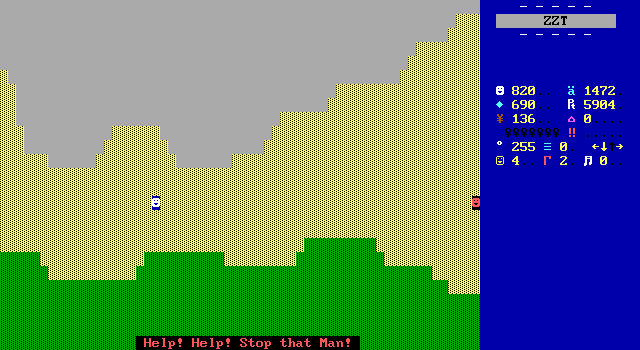
There are sometimes people at least. You can run into the mill master yelling about how the golden pitchfork was just stolen as well as an activity coordinator apologizing that farmer MacDonald is in a meeting with creditors right now.
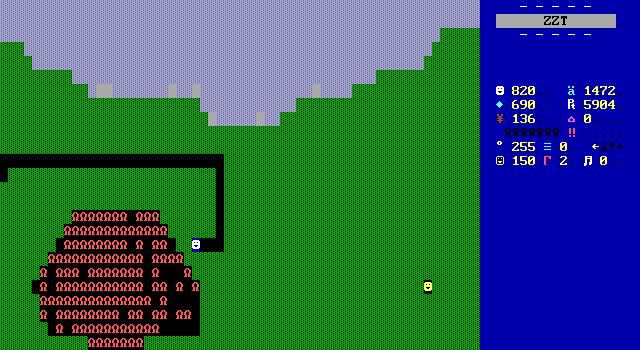
Are boards like this with nothing to do other walk across them better or worse than the zoos and mazes that came before it? The fact that I considered cracking open this giant pride of lions that could be effortlessly avoided should give you a hint as to my feelings on the matter.

Ole' McDonald (I'm noticing the game is inconsistent with the spelling) reiterates the plot, which if the player hadn't gone west from the starting board or tried to buy the third vacation package would be entirely new to them. The stakes are better established here. Steaks, or I guess cheap burgers are what will become of Bossyville if the 10,000 gem loan can't be paid soon.
The authors take a rather unusual approach to handling the way the player responds to dialog. These questions aren't words spoken by the player, but possible things for the person you're speaking with to ask. It reads very jarringly in contrast to pretty much every other world I can think of.
The loan being 10,000 gems is a peculiar number to pick for ZZT. It's a number small enough that players can actually hold that many, but large enough that the assumption is that you'll find buried treasure or something that drops the gems in your lap at once. It might not even use gems when you obtain it, and just set a flag saying you have a check for $10,000 or a diamond of equal value or whatever.
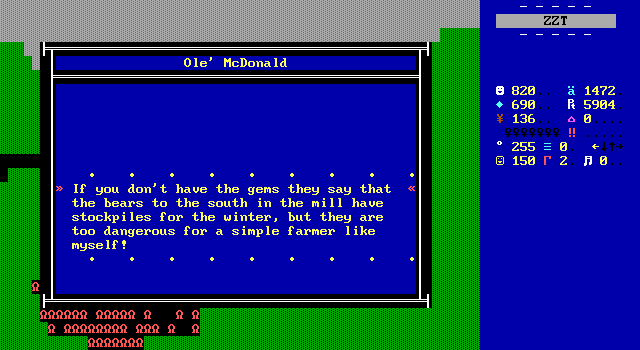
Some nearby caves are suggested for acquiring the money along with an explanation for why MacDonald hasn't gone there himself. The source of the cash will become apparent eventually.
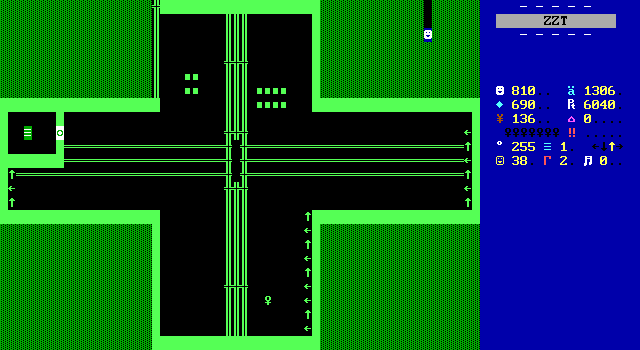
The game has a somewhat consistent map. The farm is just above the main street, and most, yet strangely not all, boards connect vertically. This applies to the boards east of the main road, leading to odd scenes like this which suggest structures hidden in the forest on the periphery of civilization.
The authors really like making where you enter a board from to matter, and care little for making sure these board connections are intuitive. The connections with main street make enough sense, and I suppose the farm's "Activity Coordinator" telling players they should explore for treasure might hint at other boards like this, but the lack of anything to suggest more to the south from the coast would make it difficult to even find a board like this without SolidHUD's board exit indicators.
Even players that take the hint and try wandering into the wilderness in hopes of finding more boards run a real risk here of doing so from a tile adjacent to the upper wall here. That's a sure-fire way to convince players that there's nothing there, and I bet caused its share of trouble back in the day.
The board itself has an interesting idea. Players are given access to a number of boulders to use as shields from blink walls and spinning guns. That's par for the course. What's unique is that typically these kind of designs revolve around rapidly firing walls and guns which force players to block them in order to get by. Here, the tempo is slower, giving the player the option of which obstacle they'd prefer to block off and which they'd rather deal with.
Truthfully, I don't think this board has had any more effort put into it than the rest. The name of this extremely green board is "purple" even. Whether through fluke or concentrated effort though, it's been the best action sequence yet.
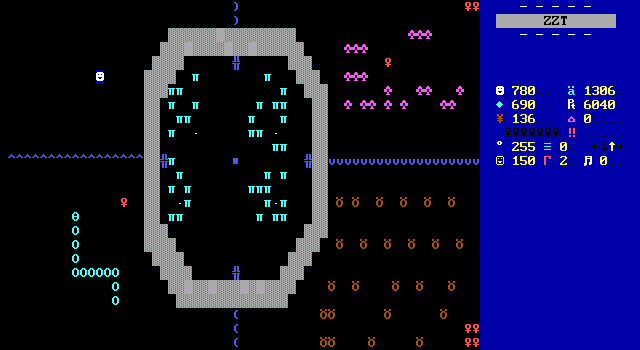
After all "purple" could have been this. This is a board that's reminiscent of Whirlpool from Dungeons of ZZT. Whirlpool is one of my favorite boards in Dungeons, making players run laps around a pool of water thanks to one-way transporters, making them grab one of a few identical keys, and then unlocking doors until the path forward is opened. The board is filled with forests with a narrow path carved through it that connects to duplicators with creatures behind it.
It keeps players moving, and if that movement lacks finesse, the forest will become wider with each lap, allowing the creatures to become more threatening as they're given more space to move around in.
Here we have no doors and no forest. The authors opt to instead use invisibles to make it difficult to repeat an identical route, which works as a sensible alternative, especially in an environment with limited foes.
The center is loaded with enemies, and some awkwardly placed duplicators that provide the possibility for more tigers to spawn in. The tigers have their intelligence set high enough that they can pretty much be ignored outside of maybe the first duplicator cycle. The tigers are similarly ignoreable thanks to the sharks that are also highly intelligent, causing them to constantly get in the way of the tigers' shots. As long as the player doesn't wander into shark bite range they will be helpful more than anything.
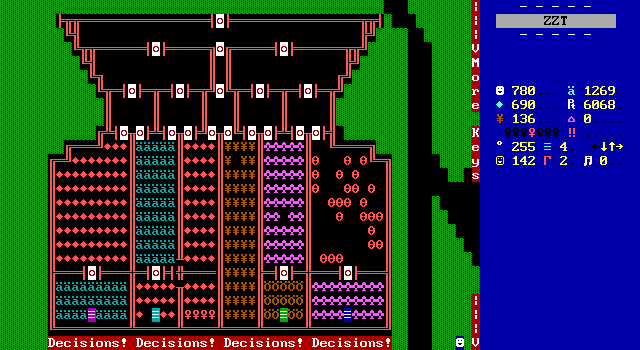
With no doors, those keys have to be for something. Another instance of an ambiguous board exit to the north will hopefully bring players to the giant milk jug where they can be put to use.
Only eight keys can be collected from the whirlpool, but four more are available here for players that tunnel their way to them. The unusual arrangement of doors makes it difficult to figure out exactly which ones need to be opened, and how many keys it requires.
These kind of boards where not every door can be unlocked often have trick rooms that prevent players from reaching a point allows them to continue. It's a design far more common in early worlds where forcing the player to reload a save isn't seen as needlessly punishing. Given how the game has been designed so far, I was operating under the assumption that there weren't anywhere near enough keys to reach all the passages. My fear was that something on the other side of one would be required and that there would be no indication of which it was. This is what safety saves are made for, but it would not be fun to have to restart the key collecting process when it span multiple boards like this.
The first passage from the left leads back to the Bolder Stash, so it's not worth the keys. The second is mission critical, taking players to the location of the stolen golden pitchfork. The third goes to the Maze-O-Doom. The fourth leads to the game's starting board. The incorrect passages feel very punishing if you don't have a recent save, throwing players back quite a number of boards. Given the convoluted path of getting here in the first place, it's rather unpleasant to be thrown all the way back to the beginning of the game.
No hints are given anywhere as to which passage leads to the pitchfork. You just have to get lucky.

